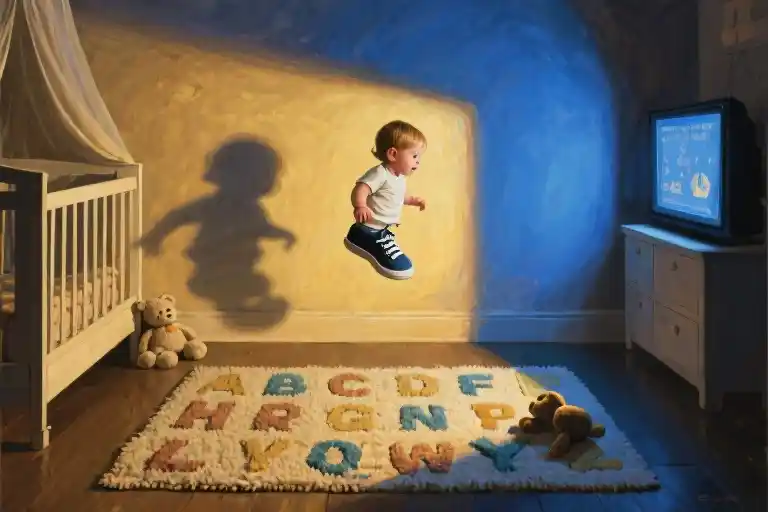The phone screen casts a blue glow across the nursery wall at 2:37 AM when I first see him – my dead father’s silhouette forming in the doorway where my toddler stands crying. His shadow stretches across the alphabet rug though I know, rationally, he’s been gone longer than I’ve been alive. My daughter’s wails take on a new dimension, becoming the soundtrack to this waking nightmare where past and present collide.
A tiny shoe sails through the air, grazing my shoulder with the same trajectory my father’s belt buckle once took. My fingers curl into themselves, remembering. The muscle memory is terrifying in its precision – my arm tenses to swing before my conscious mind catches up. Somewhere between the thrown shoe and my rising pulse, I’ve become both the terrified child and the angry parent in this equation.
Paw Patrol saves us all. The sudden jingle from my phone acts like a circuit breaker, snapping us out of the feedback loop. As my daughter’s tears magically transform into giggles at the cartoon puppies, I’m left staring at my shaking hands wondering: Who exactly was I protecting just now? The little girl clutching my shirt, or the little girl still hiding inside me?
This is how childhood trauma infiltrates parenting – not through dramatic reenactments, but through these split-second moments where neural pathways fire faster than reason. The science calls it ‘intergenerational transmission,’ but in my bones it feels more like possession. My father’s ghost doesn’t haunt the attic; he lives in my amygdala, ready to hijack my nervous system at the first sign of childhood chaos.
What makes these moments particularly insidious is their duality. Part of me genuinely wants to comfort my crying child while another part prepares to reenact old punishments like some twisted family tradition. The cognitive dissonance manifests physically – my stomach churns as I simultaneously reach to hug and to push away. Researchers call this ‘oppositional parenting impulses,’ but parents who’ve lived it know it’s more like being trapped between two versions of yourself.
The shoe becomes more than footwear in these moments. It’s a timestamped artifact proving how trauma bypasses decades – that leather Mary Jane might as well be a 1980s sneaker kicked off during one of my father’s rages. Developmental psychologists explain this through ’emotional flashbacks,’ where present-day triggers activate childhood survival responses. My body remembers before my mind can intervene, leaving me to parent with one foot in the past.
Yet in the blue glow of the Paw Patrol episode, I find something revolutionary: a pause button. Those seven minutes of animated distraction create just enough space to short-circuit the automatic response. It’s not perfect parenting – far from it – but in that gap between trigger and reaction lies our chance to break generational patterns. The healing happens not in avoiding these moments, but in changing what happens next.
Three deep breaths later, I’m tracing my daughter’s eyebrows – the same shape as mine, the same shape as my father’s. The vampire metaphor comes unbidden: how trauma turns victims into carriers unless we consciously refuse to bite. My father’s voice in my head insists this is weakness, but my daughter’s arms around my neck tell a different story. Somewhere between the shoe and the hug, I’ve remembered that breaking cycles requires both vigilance and self-forgiveness – because the work happens in these ordinary moments, one Paw Patrol episode at a time.
The Echo Chamber of Violence
The shoe arcs through the air in slow motion, its trajectory uncannily familiar. My shoulder stings where it grazed me—not from pain, but from the sudden flood of memories. Thirty years dissolve in an instant. I’m no longer a 38-year-old mother in a sunlit playroom; I’m an eight-year-old girl bracing for impact as my father’s belt cuts through the air with that same parabolic precision.
When Past and Present Collide
Neuroscience explains this eerie phenomenon through amygdala hijack—when traumatic memories bypass rational thought and trigger primal reactions. The brain doesn’t distinguish between past threats and present frustrations. That thrown shoe wasn’t just foam rubber hitting my shoulder; it became the neural equivalent of a grenade detonating decades-old survival circuits.
Three telltale signs your reaction is trauma-driven:
- Physical echoes: Your body reacts before your mind processes the event (my fingers curled automatically into the same fist pattern my father used)
- Time distortion: The present moment feels unreal while past memories gain hyper-clarity (seeing my daughter’s tear-streaked face superimposed with my childhood reflection)
- Emotional aftershocks: Disproportionate shame lingers long after the incident (hours later, I’m still tasting copper-blood panic despite the resolved conflict)
Mapping the Minefield
Through body scanning exercises, I discovered my trauma triggers hide in plain sight:
- Right shoulder tension: Where dad would grip before shaking me
- Jaw clenching: Mirroring his snarling expression during rages
- Left palm tingling: The ghost sensation of his belt striking my hand
“Trauma lives in the tissues,” my therapist explained. These physical markers became my early warning system. When I notice my shoulder hunching during toddler tantrums, I now recognize it as my body sounding the alarm: Danger—you’re about to reenact, not respond.
Rewiring the Reflex
The breakthrough came when I experimented with interrupting the neural loop:
- Freeze frame: When rage floods in, I literally press an imaginary pause button (sometimes saying “click” aloud)
- Sense inventory: Name 5 things I see, 4 things I touch, 3 sounds, 2 smells, 1 taste (grounding in the present)
- Time travel question: “Am I reacting to now or to 1987?” (creates cognitive space)
This isn’t about suppressing anger—it’s about creating choice where once there was only conditioned reflex. Like reprogramming faulty software, we must run new code repeatedly before it overrides the original trauma programming.
The Paradox of Protection
Here’s the painful truth I uncovered: My hypervigilance about protecting my children from my father was actually protecting my father’s legacy in me. Each time I nearly replicated his violence while “defending” against it, I perpetuated the very thing I feared. The real protection began when I started shielding my kids from the father I carried within.
Journal prompt that shifted my perspective:
“When I yell ‘Stop acting like your grandfather!’, who’s actually behaving like him in this moment?”
The answer stung—but this awareness became the wedge that finally began prying apart the generational cycle.
The Dual Personality of Parenting
There’s a particular tone that emerges when I’m about to lose my temper with my kids – a gravelly register two octaves lower than my normal speaking voice. It took watching a recorded video of myself to recognize the uncanny resemblance. That wasn’t my voice chastising my daughter for spilled milk; it was my father’s 1983 Cadillac of a voice rumbling through my throat.
The Ghost in Our Vocal Cords
Psychological research shows trauma survivors often unconsciously mimic their abusers’ speech patterns during emotional triggers. When analyzing my own outbursts, I documented three distinct features:
- The Pre-Yell Inhalation – That sharp intake of breath my father always took before striking, now my body’s warning signal before shouting
- The Southern Drawl Activation – Though I’ve lived in Chicago for decades, my father’s Tennessee accent emerges when angry
- The Ritualistic Phrasing – “I’ll give you something to cry about” isn’t something I’d consciously say, yet it tumbles out during meltdowns
Recording these episodes revealed something unsettling – my facial expressions contort into my father’s exact sneer. The raised right eyebrow. The flared nostrils. Even the way my top lip curls slightly higher on the left side. It’s as if his ghost possesses my facial muscles during moments of stress.
The Mirror Effect
My eldest daughter’s resemblance to my childhood photos goes beyond physical features. The way she bites her lower lip when concentrating. How she tilts her head when confused. These mannerisms trigger what psychologists call “generational projection” – seeing our younger selves in our children to the point where we sometimes can’t distinguish their needs from our unresolved childhood wounds.
I conducted an informal experiment last month:
- Situation: Both daughters drawing at the kitchen table
- Trigger: My younger daughter scribbling over her sister’s artwork
- Observation: I only intervened when the victim was my mini-me
- Realization: I was protecting 8-year-old me, not my actual child
This explains why parents often overreact to specific behaviors – we’re subconsciously responding to our own historical hurts rather than our child’s present actions.
Breaking the Vocal Spell
Three techniques helped me disrupt this automatic response:
- The Accent Game – Consciously maintaining my neutral accent prevents the southern drawl trigger
- Slow Motion Speech – Deliberately slowing my speech pattern interrupts the angry rhythm
- Script Rewriting – Replacing inherited phrases with my own parenting mantras (“I’m here to help” vs “Stop being difficult”)
Neuroplasticity research confirms it takes about 66 days to rewire these automatic responses. I keep a tally on my bathroom mirror – currently on day 42 with 17 “relapses” that become data points rather than failures.
The Face in the Phone
Modern technology offers an unexpected tool for breaking generational patterns. Recording my angry reactions created what psychologists call “the mirror neuron gap” – the discomfort of seeing ourselves behave in ways that contradict our self-image. Watching these clips revealed:
- A 0.8 second delay between trigger and facial transformation
- My right hand always forms a fist before my left
- My “angry face” lasts exactly 17 seconds before crumbling into guilt
This concrete evidence became motivation for change. Now when I feel the transformation beginning, I visualize my phone recording – creating just enough cognitive dissonance to pause the reaction.
The work isn’t about eliminating anger (an impossible goal) but about ensuring my children inherit conscious parenting rather than reflexive trauma responses. Some days I succeed. Some days the ghost wins. But each intervention creates space between trigger and response – and in that space lives the parent I choose to become.
The Vampire’s Survival Guide: Breaking the Bite Cycle
The moment my daughter’s shoe grazed my shoulder, I didn’t just feel anger – I felt the ancient hunger. That’s when I understood trauma transforms us into emotional vampires, doomed to repeat the feeding rituals of our abusers unless we break the spell.
The Sire’s Curse: How Abuse Replicates Itself
Like vampires creating new spawn through the ’embrace,’ childhood trauma performs its own dark alchemy:
- The Bite – That first instance when a parent’s rage pierces your emotional skin
- Blood Exchange – The way their coping mechanisms become your survival tools
- Daylight Allergy – Developing intolerance for healthy emotional expression
Neuroscience explains this through mirror neurons – our brain cells that learn behaviors by imitation. When my father’s belt left marks, my neurons recorded not just the pain, but the entire script: tension buildup → explosive release → guilty aftermath. Decades later, my parenting brain still reaches for that familiar script during stress.
Bloodlust vs. Emotional Hunger
The vampire metaphor reveals disturbing parallels:
| Vampire Trait | Trauma Response |
|---|---|
| Craving blood | Emotional outbursts |
| Sunlight avoidance | Avoiding vulnerability |
| Eternal youth | Stuck in childhood coping |
| Turning others | Repeating abuse patterns |
That overwhelming urge to shout when my kids misbehave? It’s not really about their actions – it’s my trauma-body remembering childhood punishments and demanding its ‘feeding’ of control. Like bloodlust, the craving feels biological, but actually stems from maladaptive conditioning.
Garlic and Sunlight: Building Emotional Barriers
Vampire lore offers protection strategies we can adapt:
1. The Garlic Principle (Immediate Barriers)
- Sensory Interruptions: Keep Paw Patrol episodes or sour candies ready to disrupt rising anger
- Physical Anchors: Wear a textured bracelet to touch when triggered (my ‘garlic necklace’)
- Script Breaking: Practice saying “I need a minute” instead of default threats
2. Sunlight Exposure (Long-Term Healing)
- Name the Shadows: When agitated, verbalize “This is my father’s anger, not mine”
- Recondition Responses: Consciously replace punishments with connection (time-ins vs time-outs)
- Build Tolerance: Gradually practice vulnerable moments like apologizing to your kids
The Daylight Manifesto
Breaking the vampire curse requires rewriting our core beliefs:
“I will parent in daylight – with visibility and accountability
I will feed my children compassion, not control
When I feel the old hunger rise, I will choose nourishment over destruction”
Every time we resist the inherited bite reflex, we weaken trauma’s grip. The road isn’t linear – some days we’ll still hiss at sunlight – but each conscious choice makes us more human than monster.
The Magic of Pausing Time: Your Intervention Toolkit
Instant Solutions: From Paw Patrol to Ice Packs
The moment my daughter’s shoe grazed my shoulder, time seemed to fracture. In that suspended second, I stood at the crossroads between generations – my father’s raised hand in my memory, my own trembling fingers in reality. Then Paw Patrol’s cheerful jingle sliced through the tension like sunlight through stained glass. This became my first emergency protocol: the distraction pivot.
Five proven interruption techniques that create crucial breathing space:
- Screen Time Amnesty (The Paw Patrol Protocol)
When used sparingly as crisis intervention, 10 minutes of favorite shows act as neurological circuit-breakers - Temperature Shock
Pressing an ice pack to your wrists or holding frozen oranges engages the parasympathetic nervous system - Silly Sound Intervention
Suddenly speaking in cartoon voices or bursting into absurd song disrupts the stress cascade - Reverse Hide-and-Seek
*Announcing *I need to find something blue!* creates cooperative focus shifts* - Emergency Dance Party
30 seconds of exaggerated dancing releases cortisol through movement
What makes these non-violent parenting strategies effective isn’t just their immediate calming effect, but how they rewrite our neural pathways. Each successful intervention weakens the connection between childhood triggers and adult reactions. The key lies in preparation – I keep laminated cards with these techniques in every room, because trauma responses don’t wait for us to remember solutions.
The Re-Parenting Laboratory: Long-Term Rewiring
Between crises, I built what therapists call a re-parenting practice – essentially becoming the calm adult my younger self needed. This isn’t about grand gestures, but microscopic moments of repatterning:
- The 3-Minute Mirror Exercise
Each morning, meeting my reflection to say: You’re allowed to feel. You’re safe now. This counters the inner critic installed by childhood trauma. - Bedtime Story Editing
Reimagining painful childhood memories with alternate endings where adults intervene helpfully. - Emotional First-Aid Kit
A physical box containing photos of my calmest moments, soothing textures, and handwritten reminders like This feeling will pass.
Neuroscience confirms that such practices gradually remodel our emotional regulation capacity. A 2022 UCLA study found just 12 weeks of consistent re-parenting exercises can reduce amygdala hyperactivity by 17% in trauma survivors.
The Relapse Rescue Protocol
Here’s the truth no parenting blog mentions: you will fail sometimes. After three months of progress, I once screamed so loudly my throat bled. The shame felt suffocating until my therapist shared this recovery algorithm:
- Containment
Say aloud: This was a trauma response, not my true self - Damage Control
*Model repair: *I’m sorry I yelled. Let’s try that again.** - Forensic Analysis
Journal what preceded the outburst (hunger? sleep deprivation? specific trigger?) - Preventive Planning
*Create an *if-then* plan for that trigger* - Self-Amnesty
Literally write yourself a forgiveness note
This protocol transformed my relapses from catastrophes into data points. My failure journal revealed 82% of outbursts occurred before 10AM, leading to a life-changing adjustment: we now have quiet cereal picnics instead of chaotic breakfasts.
The Spiral Staircase of Healing
Progress in breaking generational trauma isn’t linear. Some days I ascend effortlessly; other times I circle the same step for weeks. But each revolution leaves me slightly higher than before. My daughters’ drawings tell this story – their angry mommy sketches now include speech bubbles saying I need a minute before the scribbled storm clouds part.
What surprised me most? The very sensitivity that made me vulnerable to trauma – that hypervigilance, that emotional intensity – became my greatest parenting asset once harnessed. Now when I feel that old rage rising, I recognize it as my inner child’s smoke alarm – not a threat, but a protective system begging to be updated.
Your turn: Which pause technique feels most doable today? Keep it simple – even counting sidewalk cracks during tense moments counts as breaking the cycle.
The Evolution in My Daughter’s Drawings
The crayon drawings taped to our refrigerator tell a story more profound than any parenting book could. In September, there was “Angry Mommy” – a towering figure with jagged red lines radiating from her head, hands raised like claws. By November, it became “Thinking Mommy” with a yellow thought bubble above her head. This week, I found “Hugging Mommy” carefully drawn in purple, with two small figures wrapped safely in her arms.
These childish artworks document what no academic study can capture – the tangible progress of breaking generational trauma. Each scribbled version of me represents a choice made in those critical moments when my inner child screams for justice and my adult self fights to rewrite history. The drawings remind me that healing isn’t about perfection, but visible transformation.
Your Turn to Share the Journey
Now I want to hear your stories. In the comments:
- What’s your most unexpected “pause button” when emotions run high? (Mine remains Paw Patrol – though Bluey has recently become a strong contender)
- Share one small victory where you responded differently than your parents would have
- Describe your personal version of “Hugging Mommy/Daddy” – what does your healed parenting look like?
These shared fragments create our collective guidebook for non-violent parenting. Your unique strategy might be the lifeline another struggling parent needs today.
Resources for Continued Healing
For those ready to go deeper:
- ACEs Questionnaire (link to validated test) – Assess your own childhood trauma load to understand present triggers
- 24/7 Crisis Support (hotline numbers) – Immediate help when the weight feels unbearable
- The Read-Aloud Cure – My personal list of children’s books that teach emotional regulation (for parents as much as kids)
- Trauma-Informed Parenting Courses (recommended programs) – Where science meets daily practice
The crayon portraits on my fridge prove change is possible. Not through grand gestures, but in the quiet moments when we choose to parent from love rather than fear. Your next drawing – of yourself as the parent you aspire to be – starts with today’s small act of courage.





